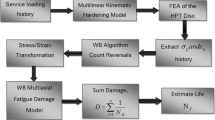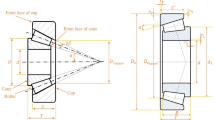Abstract
The article is devoted to the gantry crane metal structure basic elements’ gamma-percentage fatigue life calculation. Metal structures of most gantry cranes are prone to cracking during operation. The presence of cracking centers indicates that the base parts operation life is lower than the estimated service life of the machine. Therefore, it is necessary to analyze and consider possible methods to optimize the fatigue life.
Access provided by Autonomous University of Puebla. Download conference paper PDF
Similar content being viewed by others
Keywords
1 Introduction
Overhead gantry cranes are a complex multi-component hoisting machine (HM), which safety is a defining parameter both during its creation and during operation, which, in particular, is ensured by the correct choice of structural and strength indicators of the load-bearing metal structures’ elements.
The issues of reliability and safety, assessments and forecasting of the mechanical systems’ technical state, including in relation to the elements of the first responsibility group, the failure of which can lead to accidents, were addressed by V.E. Kasyanov, V.V. Bolotin, V.I. Braude, A.V. Vershinsky, M.M. Gokhberg, A.A. Zaretsky, A.A. Korotkiy, V.S. Kotelnikov, A.S. Lipatov, I.A. Makhutov, A.N. Orlov, N.N. Panasenko and other scientists.
Calculation of HM elements is recommended to perform considering the limit states according to the condition of static and cyclic strength. In the calculations, the bearing capacity is understood as such a load, under the action of which the element reaches the limit state, that is, its further operation ceases. When calculating HM there are a number of limiting states, which are divided into two groups: 1 - by the structure bearing capacity exhaustion; 2 - upon reaching the conditions that disrupt normal operation.
The main condition for maintaining the bearing capacity of metal structures and mechanisms’ elements is compliance with the requirement that the forces acting in the element do not exceed its bearing capacity.
According to the responsibility degree, HM elements are divided into two groups: the first includes the elements, the failure of which can lead to an accident and poses a danger to human life, the rest of the elements belong to the second group of failure, which can only lead to economic losses.
The reliability of the hoisting-and-transport machines’ elements depends on their bearing capacity and operational loads, which is characterized by the reliability and durability indicators. Reliability is characterized by the likelihood of failure-free operation, and durability is determined by the gamma-percentage resource.
In this paper, we consider the case in which the limiting state occurs as a result of the bearing capacity exhaustion according to the condition of cyclic strength, and durability is considered as an indicator of reliability.
2 Materials and Methods
In order to ensure the HM load-bearing metal structures’ durability, this paper proposes an algorithm for calculating the gamma-percentage resource for a population based on the sample data, which is shown in Fig. 1. In this algorithm, in block 6, a method is implemented for switching from a sample to a finite volume population using an analytical technique that makes it possible to obtain the fatigue resource distribution for an aggregate with a small amount of statistical information at the design stage [1, 2].
The calculation of the gamma-percentage fatigue resource involves the determination of a typical loading process for base metal structures and the strength characteristics of the materials used for their manufacture in order to identify the areas susceptible to possible cracking.
As an example, the calculation of the gamma-percentage fatigue resource for the arm and gib of the “Kirovets” 16/20 overhead reloading gantry crane has been performed.
Where: Kσi is a factor taking into account the concentration of stresses from welding; β is a surface condition factor; εσ is a coefficient that takes into account the influence of the absolute dimensions of the cross-section on the endurance limit of the part; ψσ is a coefficient taking into account residual stresses during welding; N0 is the base number of load cycles; Np is a population size; ap is the sum of relative fatigue damage; m1 is the fatigue slope; γ is a specified probability of failure-free operation; Ap, Bp, Cp show the Weibull distribution parameters of the population Tpi; σ−1 is the steel endurance limit; σavw defines weighted average stress.
The typical process of loading the metal structure of this crane can be conditionally divided into two cyclic processes: regular and irregular. The regular process includes the process of periodically repeated operations with the load (lifting - turning - lowering), the loading parameters of which are: an increase in the load from σ3 up to σav for the period t1; load holding σav during t2; decrease in load from σav up to σ3 during t3 [3].
In this case, the scope ∆σ1 = σav − σ3. An irregular process includes random loads that occur during the period t2 peak-to-peak ∆σ2 = σ1 − σ2 under braking conditions, random external influences, wind gusts, etc. Such loads are random in nature and are estimated by probabilistic distribution laws.
Meaningfulness summary Xв by parameters ρ1, σ2, σ3, σav, ∆σ1, ∆σ2. The results analysis shows that the level of maximum stresses σ1 in structural elements is much lower σt = 240 MPa.
σ1 = 45,60…66,67 MPa; σ2 = 42,79…57,03 MPa; σ3 = 13…28 MPa; ∆σ1 = 31,10…33,50 MPa; ∆σ2 = 4,28…11,35 MPa; R1 = 0,29…0,51; R1 = 0,85…0,94;
The frequency range of random loads is 0,8…1,7 Hz, the damping time of oscillations in the gib system elements lies within 4…6 s, portal 2…4 s. The duration of the crane operation cycle is from 30 to 50 s depending on the technology and handling work type.
To determine the most loaded sections of the metal structure, a solid-model was developed and FEM analysis (original drawings of material handling equipment plant named after S.M. Kirov, Russian Federation, St. Petersburg). The construction of the model and the mesh of finite elements was carried out in the Compass 3D software package at a scale of 1:1 (Figs. 2 and 3).
It is proposed to determine the gamma-percentage resource for the population using the algorithm (Fig. 1) according to the sample parameters of Weibull’s law [4,5,6,7].
The gamma-percent fatigue life of the gib and arm of the overhead gantry crane must correspond to the planned service life [8], namely 20 years. For such a long period of time, the number of operating cycles of the “Kirovets” 16/20 reloading gantry crane will be n = 0,24…1,5⋅107 depending on the work intensity and production needs. When transporting bulk cargo in sea and river ports, 24-h shift work is often organized, in 2 shifts of 12 h. At various factories for the materials and mining enterprises production, a 24-h shift is organized in 2 and 3 shifts, 12 and 8 h, respectively. Therefore, the number of hours worked during the service life can be significant - 0,4…1,6⋅105 h.
In the passport characteristics of the “Kirovets” 16/20 reloading gantry crane the annual capacity of the crane is 1200000 t in the grab and 400000 t in hook modes. Therefore, considering the operation of the crane in the grab mode, we have 2,4 … 3⋅106 working cycles for 20 years, depending on the volumetric mass of the overloaded cargo and the capacity of the grab.
Depending on the duration of the crane operation cycle from 30 to 50 s to complete this many cycles, it will take 2…5⋅104 h.
As a result of the crane operation possible values’ analysis in hours for the service life and the rated productivity per year, it is advisable to choose the average value 6⋅104 h as the optimal value when calculating the gamma percent fatigue life.
As a result of the simulation, the variational series of structural steels’ strength characteristics were obtained and the distribution parameters of the extreme members of the samples for steels were determined St. 3, 09G2S, 10HSND. The calculation of the parameters for the samples was carried out in the STATISTICA 6.0 software package, and for the population according to the method shown in Fig. 4. After that, the values of the gamma-percentage fatigue resource were found Trγ at γ = 99,9%, the results are entered in Tables 1 and 2. A gib is considered as a calculation example.
3 Research Results
Calculations using the proposed algorithm showed that the optimal resource value according to the total unit costs criterion is 60 thousand hours at γ = 99,9% using 09G2S 12 mm steel. The distribution density graph for the sample resource and the population is shown in Fig. 5. This graph shows that the fatigue life values calculated from the sampled data are overestimated, which in turn can lead to premature failures.
4 Conclusions
Thus, the fatigue life calculation according to the proposed algorithm makes it possible to reduce the risk of premature failures, which gives an opportunity to ensure operational safety, reduce accident risks, reduce operating costs and damage from HM downtime and the associated mechanized complex.
References
Kasyanov, V.E., Kotesov, A.A., Kotesova, A.A.: Analytical parameters’ determination by the Weibull law for the general set of finite volume based on the sample data of steel strength. Eng. J. Don 2 (2012)
Kotesova, A.A., Teplyakova, S.V., Popov, S.I., Kopylov, F.C.: Ensuring assigned fatigue gamma percentage of the components. IOP Conf. Ser. Mater. Sci. Eng. 698 (2019). https://doi.org/10.1088/1757-899X/698/6/066029
Gokhberg, M.M.: Metal Structures of Hoisting and Transport Machines. Mechanical Engineering, Moscow (1969)
Deryushev, V.V., Zaitseva, M.M., Evseev, D.Z., Kosenko, E.E.: Concentration of thermal stresses in metal materials and constructions under local heating. Mater. Sci. Forum 974, 729–734 (2020)
Teplyakova, S.V., Kotesova, A.A., Popov, S.I., Kotesov, A.A.: The transition from the sample data to the total aggregate of the final volume and the analysis of this transition laws. IOP Conf. Ser. Mater. Sci. Eng. 913(4), 042054 (2020)
Teplyakova, S.V., Kotesova, A.A., Kotesov, A.A.: Theoretical substantiation of ensuring the machine parts’ reliability for the assigned target life. IOP Conf. Ser. Mater. Sci. Eng. 83, 012067 (2021)
Deryushev, V.V., Zaitseva, M.M., Kosenko, E.E., Kosenko, V.V.: The quality analysis of the anti-corrosion coatings metal structures operating in difficult conditions. IOP Conf. Ser. Mater. Sci. Eng. 913(4), 042059 (2020)
Author information
Authors and Affiliations
Editor information
Editors and Affiliations
Rights and permissions
Copyright information
© 2022 The Author(s), under exclusive license to Springer Nature Switzerland AG
About this paper
Cite this paper
Kotesova, A., Kotesov, A. (2022). Algorithm for Calculating the Gib and Arm Gamma-Percentage Fatigue Life of the Overhead Gantry Crane for the Finite Volume Universe General Population. In: Manakov, A., Edigarian, A. (eds) International Scientific Siberian Transport Forum TransSiberia - 2021. TransSiberia 2021. Lecture Notes in Networks and Systems, vol 403. Springer, Cham. https://doi.org/10.1007/978-3-030-96383-5_122
Download citation
DOI: https://doi.org/10.1007/978-3-030-96383-5_122
Published:
Publisher Name: Springer, Cham
Print ISBN: 978-3-030-96382-8
Online ISBN: 978-3-030-96383-5
eBook Packages: EngineeringEngineering (R0)








